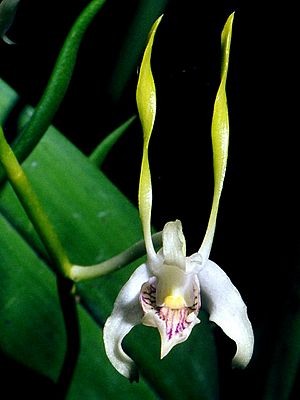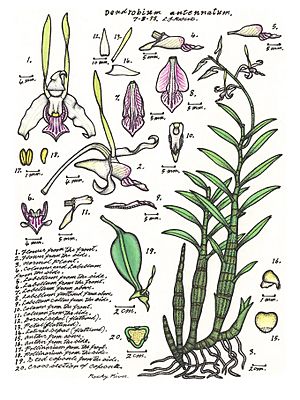Antelope orchid facts for kids
Quick facts for kids Antelope orchid |
|
|---|---|
 |
|
| Scientific classification | |
| Synonyms | |
The Dendrobium antennatum, often called the green antelope orchid, is a special type of orchid. It is an epiphytic plant, which means it grows on other plants, like trees, but it does not harm them. Instead, it gets its water and nutrients from the air and rain.
This orchid has long, tube-shaped stems called pseudobulbs. It also has up to twelve leaves near the top of these stems. The green antelope orchid produces beautiful white flowers with green petals. Its special lower petal, called a labellum, is white with purple stripes. This unique orchid grows in New Guinea and in tropical North Queensland, Australia, where it is quite rare.
Contents
What Does the Antelope Orchid Look Like?
The green antelope orchid is an epiphytic plant. This means it grows on other plants, like trees, but it does not take food from them. It has yellowish-green stems, called pseudobulbs, that are shaped like cylinders. These pseudobulbs can be about 300–600 mm (10–20 in) long and 20–25 mm (0.8–1 in) wide.
Leaves and Flowers
Each pseudobulb has between eight and twelve egg-shaped leaves. These leaves are about 80–140 mm (3–6 in) long and 30–40 mm (1–2 in) wide. They grow on the upper two-thirds of the pseudobulb.
The orchid's flowering stems grow from the upper parts of the leaves. These stems are about 200–350 mm (8–10 in) long. Each stem can have between three and fifteen flowers.
Flower Details
The flowers are mostly white and are about 50–60 mm (2.0–2.4 in) long and 40–50 mm (1.6–2.0 in) wide. However, their petals are a pale green color.
- The top sepal (a leaf-like part of the flower) is a narrow triangle shape. It is about 16–20 mm (0.63–0.79 in) long and 4–5 mm (0.16–0.20 in) wide. It usually curls to one side.
- The side sepals are also narrow and triangular. They are about 13–16 mm (0.5–0.6 in) long and 6–7 mm (0.2–0.3 in) wide. These sepals curve backwards.
- The petals are long and narrow, like a spearhead. They are about 35–40 mm (1–2 in) long and about 4 mm (0.2 in) wide. They stand up straight and are twisted, which makes them look a bit like antelope horns.
- The labellum (the special lower petal) is white with purple stripes. It is about 25 mm (1 in) long and 12 mm (0.5 in) wide. It has three parts, called lobes. The two side lobes curve upwards. The middle lobe is pointed and has five ridges along its center.
This orchid usually flowers from March to December, and its beautiful flowers last for a long time.
How Was the Antelope Orchid Named?
The Dendrobium antennatum was first officially described in 1843. This means it was given its scientific name and details by a scientist named John Lindley. He studied a plant sample that was collected in New Guinea by Richard Brinsley Hinds.
Where Does the Antelope Orchid Live?
The green antelope orchid mostly grows in rainforests near the coast. It can be found from sea level up to about 1,200 m (3,900 ft) high. You can find it in the McIlwraith Range on Cape York Peninsula in Australia, as well as in the Solomon Islands and New Guinea.
Is the Antelope Orchid Protected?
Yes, this orchid is considered "endangered" by the Australian Government. This means it is at risk of disappearing from the wild. It is protected under a law called the Environment Protection and Biodiversity Conservation Act 1999. This law helps to protect plants and animals that are in danger.
See also
 In Spanish: Dendrobium antennatum para niños
In Spanish: Dendrobium antennatum para niños


